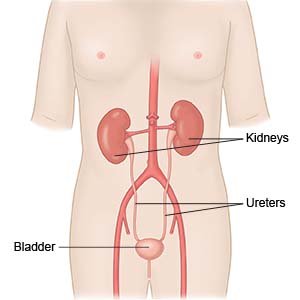Cystectomy with Continent Cutaneous Urinary Diversion
Medically reviewed by Drugs.com. Last updated on Aug 4, 2025.
WHAT YOU NEED TO KNOW:
Cystectomy with continent cutaneous urinary diversion is surgery to remove your bladder. Your surgeon will create a new way for urine to drain out of your body. He or she will make a new bladder from a piece of your intestine. The new bladder will be connected to an opening called a stoma on your abdomen. You will empty urine through a catheter you will guide through the stoma and into the new bladder.
 |
HOW TO PREPARE:
The week before your surgery:
- Your surgeon will tell you how to prepare for surgery. Arrange to have someone drive you home after surgery.
- Tell your surgeon about all medicines you currently take. He or she will tell you if you need to stop any medicine for surgery, and when to stop. He or she will tell you which medicines to take or not take on the day of surgery.
- You may need antibiotics to help prevent an infection caused by bacteria.
- Your surgeon may tell you to eat foods high in fiber the weeks before surgery. This will help you have bowel movements and clean out your intestines. You may also need an enema before your surgery. This is liquid put into your rectum to help empty your bowel.
- You may need blood or urine tests. You may also need x-rays or a CT scan of your kidneys, bladder, or ureters.
The night before your surgery:
You may be told not to eat or drink anything after midnight.
The day of your surgery:
- You or a close family member will be asked to sign a legal document called a consent form. It gives healthcare providers permission to do the procedure or surgery. It also explains the problems that may happen, and your choices. Make sure all your questions are answered before you sign this form.
- Take only the medicines your surgeon told you to take.
- An IV will be placed in a vein. You may be given medicine or liquids through the IV.
WHAT WILL HAPPEN:
What will happen:
- You will be given general anesthesia to keep you asleep and free from pain during surgery. Your surgeon will make an incision near your belly button. He or she will remove your bladder and may remove nearby organs. In men, the organs include the prostate and seminal vesicles (glands near the prostate). In women, the organs include the uterus, cervix, ovaries, and fallopian tubes. Your surgeon may also remove part of the urethra and lymph nodes near your bladder.
- Your surgeon may remove part of your intestine. He or she will make a new bladder by connecting the section of intestine to your ureters. Two small stents (tubes) will be placed inside the ureters into the kidney to help urine drain while you heal. He or she may also use part of your appendix. The incision will be closed with stitches or staples. You will learn to empty your urine by pushing the urine out. You will use pelvic abdominal muscles to help push out the urine.
- Your surgeon may instead connect your 2 ureters to a pouch on one end. The other end attaches to the opening on your abdomen. The opening will be covered with a bandage. Urine will collect in the pouch and you will need to use a catheter to drain urine from the pouch.
After your surgery:
You will be taken to a room to rest until you are fully awake. Healthcare providers will monitor you closely for any problems. Do not get out of bed until your healthcare provider says it is okay. When your healthcare provider sees that you are okay, you will be able to go home or be taken to your hospital room.
CONTACT YOUR HEALTHCARE PROVIDER IF:
- You have a fever.
- You have questions or concerns about your surgery.
Risks
Surgery may increase your risk for bleeding or infection. Urine may leak where the ureters are connected to the section of intestine. Your ureters may also become blocked and not empty urine. You may develop a life-threatening blood clot.
Related medications
Care Agreement
You have the right to help plan your care. Learn about your health condition and how it may be treated. Discuss treatment options with your healthcare providers to decide what care you want to receive. You always have the right to refuse treatment.© Copyright Merative 2025 Information is for End User's use only and may not be sold, redistributed or otherwise used for commercial purposes.
The above information is an educational aid only. It is not intended as medical advice for individual conditions or treatments. Talk to your doctor, nurse or pharmacist before following any medical regimen to see if it is safe and effective for you.
Learn more about Cystectomy with Continent Cutaneous Urinary Diversion
Care guides
Further information
Always consult your healthcare provider to ensure the information displayed on this page applies to your personal circumstances.
